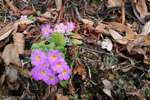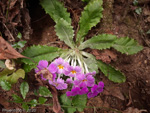Primula bracteosa Craib
Section Petiolares
Link to Flora of China description
Flora of Bhutan
Link to Nepal checklist
Type specimen: Cooper 3981 resides at E (specimen E00024647).
P. boothii Craib (syn) : Type specimen: Watt 2179 resides at E (specimen E00024648).
Epithet: Named for the scape-leaves which form at the top of the scape when fruiting.
Distribution: Bhutan, Sikkim, Nepal, Tibet.
Difficult to distinguish from other species when in flower, but when in fruit, it is characterized by the scape-leaves which form at the top of the scape. These leaves grow large and too heavy for the scape, which bends down and eventually roots, forming a new plant. The scape does not persist, but rots away. A high percentage of plants produce scape-leaves but not all of them. Dimorphic leaves with inner ones spathulate with a broad short petiole, and outer ones with an ovate to oblong-ovate blade and a distinct petiole. Early leaves, pedicels, calyx and scape are farinose, then becomes efarinose. Scape is very short at first and then elongates with age. P. boothii has been shown to be the same species. Occurs in western Sikkim and thought to occur in Nepal.
























